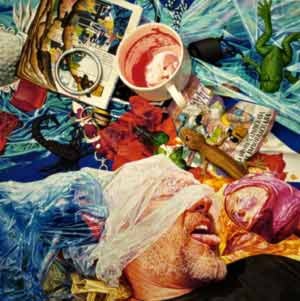Everybody wanted to step on the art.
Craning and peering, people milled around Jane Adeney’s Fault Line at the exhibit’s opening Thursday night at the Yukon Arts Centre Public Gallery.
Her row of smoke-fired earthenware boxes rested in the centre of the room, surrounded by a bed of shiny black stones.
A warm glow emanated from cracks in each box, creating a rupture that appeared to span the seven cubes.
Each had something inside, but it was hard to peer through the cracks.
The rocks were in the way.
“I first showed this piece at the Art Gallery of Hamilton,” said Adeney.
“And after a few days, the gallery called me and said, ‘People want to step on your stones.’
“They want to see what’s in the boxes.”
It’s a transgressional piece, said Adeney, as she watched viewers lean over the work, trying to get a glimpse inside.
“If you want to know what’s in the boxes badly enough, you have to break the rules.”
That night no one did — although one person was overheard plotting to return when the gallery was less crowded.
The rocks keeping people at bay have their own unique history.
Adeney originally wanted to use charcoal, but this would have destroyed the gallery floor.
So she bought 16 bags of crushed gravel and some cans of Tremclad paint.
She then tried dunking the rocks, spraying them, coating them, but nothing really covered all the sides and angles.
“I finally ended up painting each one by hand,” she said.
Fault Line was originally created just before the new millennium.
“So, it’s full of portent and power,” said Adeney.
But after the turn of the century, the piece took on new meaning, she said.
“I want meaning in my works to be read in a number of ways, rather than having a singular interpretation.
“And the smoke-firing process becomes part of the way I construct meaning.
“Fire or burning transforms things and this visual theme of fire reflects our human struggle for transcendent meaning.”
Crackling on the walls around Adeney’s smoke-fired pieces, are large fiery paintings by Catherine Gibbon.
The two women, after showing at the same gallery in Ontario, noticed the commonality in their work and decided to create a joint exhibit.
“Both of us have this idea of transformation and destruction as part of creation,” said Adeney.
Billows of smoke fill Gibbon’s canvases as fire licks up spruce and consumes forests.
In the next room, John Hall and Alexandra Haeseke share a strikingly different exhibit.
Plastic dog toys, shiny gold wrestling masks from Mexico and hyper-realistic faces push through rips in paper and plastic, and jump out from the walls.
The room is full of bright, cheap colour.
The paintings, a bizarre collage of Mexican mementos and wrestling references, are disturbingly realistic.
Following Picasso’s cubism, art moved toward postmodernism, reaching its zenith with Duchamp’s urinal, said Hall.
But now, there is a return to realism.
“And this is what’s important to us, rather than conceptual art,” he said.
Drawing on postmodern notions, Hall and Haeseke’s realistic paintings are two-sided creations.
“They have dual input,” said Haeseke.
“Because they were created by a male and a female. And each work has impact and intent, beauty and repulsion, wonder and apprehension.”
Haeseke and Hall have been friends for 35 years and started spending time together in central Mexico.
“These paintings grew out of the conversations we had over dinner and tequila,” said Haeseke.
In their first collaboration, the friends passed two canvases back and forth, adding something each time.
Interested in dogs, Haeseke put a pooch in the foreground of one. Hall added a stunning sunset. Haeseke drew in some colourful, hanging dog toys and they thought it was complete.
But Hall suddenly asked for it back and added this pre-Columbian figurine on a swing, said Haeseke.
Intrigued by the collaboration, the two artists decided to take it further.
“We decided to work on imagery from the very beginning,” she said.
Gathering objects from Mexican markets and from their studios, including some of their favourite masks, they created and photographed collages, then painted them.
“The idea was that we, as foreigners, were caught up in this vivid, hot culture, in this deluge of visceral materials,” said Haeseke, who actually used Jell-O as subject matter in some of the collaborative creations.
“So, our work is a celebration of beautiful surfaces, and finding those things that delight the eye.”
The two artists approached each canvas differently, depending on the work.
Sometimes Haeseke would paint the bottom half and Hall the top. Or they would each pick parts of the work they wanted to paint.
And two of the works in the gallery were painted by just one of the artists.
But it was nearly impossible to tell who had painted what.
Hall paints with solid form and colour, said Haeseke.
“And I do thin transparent washes.”
But this tip didn’t help.
People trying to guess who painted what in the works, kept getting it wrong.
If Mexican wrestlers, absurd, bright collages and burning forests get a little overwhelming, the third gallery offers a peaceful reprieve.
Filled with faded, sepia, landscape photos, Mario Villeneuve’s pinhole camera work examines the Yukon from a new, earthy perspective.
The exhibits run until October 29th. The public gallery is open Tuesday through Friday 12 p.m. to 6 p.m., and on the weekend from 12 p.m. to 5 p.m.
